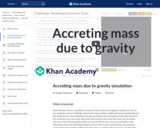
The simulation Sal mentions in the video can be found directly following this video in the lesson.
- Subject:
- Astronomy
- Physical Science
- Material Type:
- Lesson
- Provider:
- Khan Academy
- Provider Set:
- Khan Academy
- Author:
- Sal Khan
- Date Added:
- 12/07/2012

The simulation Sal mentions in the video can be found directly following this video in the lesson.
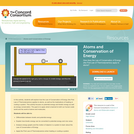
In this activity, students will explore how the Law of Conservation of Energy (the First Law of Thermodynamics) applies to atoms, as well as the implications of heating or cooling a system. This activity focuses on potential energy and kinetic energy as well as energy conservation. The goal is to apply what is learned to both our human scale world and the world of atoms and molecules.
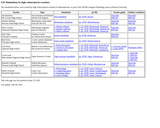
This web page features a collection of Easy Java Simulations developed by secondary teachers for use in introductory high school physics courses. Topics include astronomy, momentum and collision, projectile motion, Gauss's Law and electric field, special relativity, and more. Each simulation is accompanied by a standards-based lesson plan and printable student guides. Users may run the simulations as a Java applet or may directly download a jar file version. The materials in this collection were created with Easy Java Simulations (EJS), a modeling tool that allows users without formal programming experience to generate computer models and simulations. To modify or customize the model, See Related Materials for detailed instructions on installing and running the EJS Modeling and Authoring Tool. This resource is part of Project ITOP (Improving the Teaching of Physics), a graduate program offered at University of Massachusetts-Boston. The archived computer models are hosted and maintained as part of the BU Physics Simulation collection.
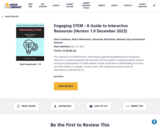
This collection of STEM (Science Technology Engineering Mathematics) interactive resources is a practical guide that teachers will find useful in helping students achieve curriculum expectations in STEM related courses, build their understanding of science and their ability to engage in science talk, offer explanations about natural phenomena, and develop digital literacy and a sense of global citizenship. The guide also provides instructional design considerations for developing active learning activities, pedagogical strategies, and sample activities.
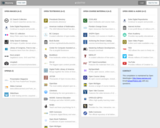
If you haven’t discovered already, there are myriad open resources that exist. Often the trouble lies in locating those that fit precisely what you need. Washington State Board for Community and Technical Colleges has collected these resources by category with the intent of making the search process more efficient and effective.
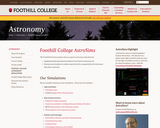
The Foothill College AstroSims project is ensuring continued access to astro-education simulations past the deprecation of Java and Flash. This site includes:
* re-implementations in HTML5/Javascript of existing astro-education simulations,
* new simulations of previously unaddressed topics, and
* a frequently updated list of astro-education simulations.

The objective of this course is to introduce large-scale atomistic modeling techniques and highlight its importance for solving problems in modern engineering sciences. We demonstrate how atomistic modeling can be used to understand how materials fail under extreme loading, involving unfolding of proteins and propagation of cracks.
This course was featured in an MIT Tech Talk article.

This workshop is designed to introduce students to different perspectives on politics and the state of the world through new visualization techniques and approaches to interactive political gaming (and selective ’edutainment’). Specifically, we shall explore applications of interactive tools (such as video and web-based games, blogs or simulations) to examine critical challenges in international politics of the 21C century focusing specifically on general insights and specific understandings generated by operational uses of core concepts in political science.

An introductory course on teaching and learning science and mathematics in a variety of K-12 settings. Topics include education and media, education reform, the history of education, simulations, games, and the digital divide.

Transport is among the most fundamental and widely studied phenomena in science and engineering. This subject will lay out the essential concepts and current understanding, with emphasis on the molecular view, that cut across all disciplinary boundaries. (Suitable for all students in research.)
Broad perspectives of transport phenomena
From theory and models to computations and simulations
Micro/macro coupling
Current research insights
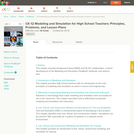
A collaboration between the National Aeronautics and Space Administration (NASA) and the CK-12 Foundation, this book provides high school mathematics and physics teachers with an introduction to the main principles of modeling and simulation used in science and engineering. An appendix of lesson plans is included.
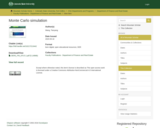
Lecture notes defining Monte Carlo simulations, and introducing applications
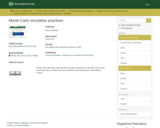
Lecture notes for examples of using Monte Carlo simulations
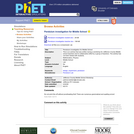
Middle school lab activity promoting physics and math learning.

15.668 People and Organizations examines the historical evolution and current human and organizational contexts in which scientists, engineers and other professionals work. It outlines today’s major challenges facing the management profession. The course uses interactive exercises, simulations and problems to develop critical skills in negotiations, teamwork and leadership. Students will be introduced to concepts and tools to analyze work and leadership experiences in optional undergraduate fieldwork projects.

This is the textbook of a graduate course given in 2024 at the University of Twente on "Scientific computing with open-source software".
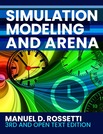
Discrete-event simulation is an important tool for the modeling of complex systems. Simulation is used to represent manufacturing, transportation, and service systems in a computer program to perform experiments on a computer. Simulation modeling involves elements of system modeling, computer programming, probability and statistics, and engineering design. Simulation Modeling and Arena, by Dr. Manuel Rossetti, is an introductory textbook for a first course in discrete-event simulation modeling and analysis for upper-level undergraduate students as well as entering graduate students. The text is focused on engineering students (primarily industrial engineering); however, the text is also appropriate for advanced business majors, computer science majors, and other disciplines where simulation is practiced. Practitioners interested in learning simulation and Arena could also use this book independently of a course.

This course uses computer-based methods for the analysis of large-scale structural systems. Topics covered include: modeling strategies for complex structures; application to tall buildings, cable-stayed bridges, and tension structures; introduction to the theory of active structural control; design of classical feedback control systems for civil structures; and simulation studies using customized computer software.